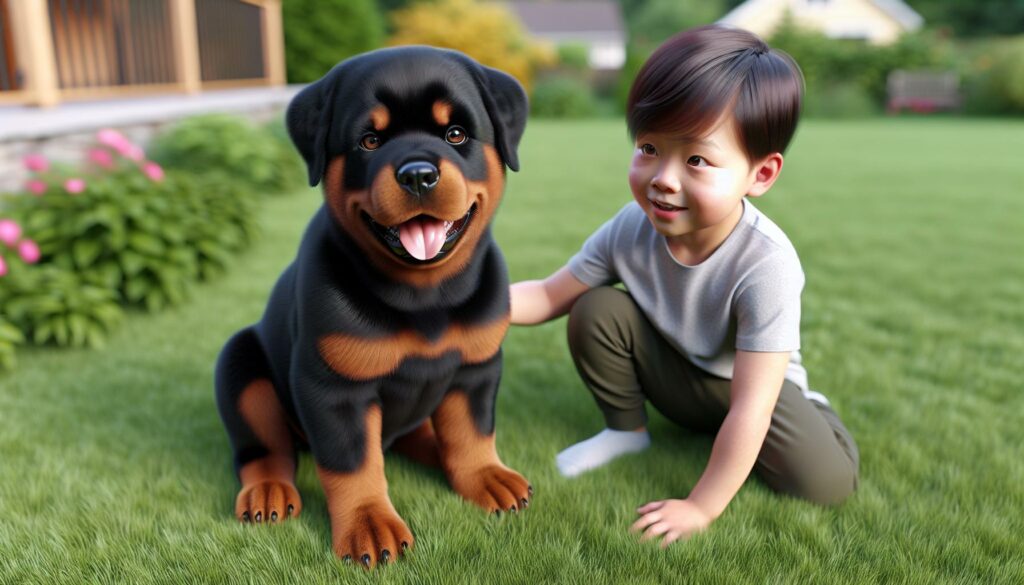Rottweilers are often misunderstood, and I can’t help but feel passionate about changing that perception. These loyal and intelligent dogs make incredible companions, especially when raised from a young age. If you’re considering bringing a Rottweiler puppy into your home, you’re in for a rewarding experience filled with love and joy.
- Understanding Rottweilers: Rottweilers, including the Baby:Vnjaycz5Pjs= variant, are loyal and intelligent companions that require early socialization and consistent training for optimal behavior.
- Physical Characteristics: This breed features a robust build, standing 22 to 27 inches tall and weighing between 80 to 135 pounds, with a short, dense coat that typically showcases a black and tan color pattern.
- Temperament Traits: Baby:Vnjaycz5Pjs= Rottweilers are affectionate, protective, and versatile, making them suitable for various roles, from family pets to service dogs.
- Care Requirements: Proper care includes a balanced diet high in protein and fat, routine veterinary check-ups, and regular grooming, vital for their health and well-being.
- Exercise Needs: Rottweilers require 60 to 90 minutes of daily physical activity, combining structured exercises and playtime to ensure mental and physical stimulation.
- Importance of Socialization: Engaging with other dogs and people is crucial for Baby:Vnjaycz5Pjs= Rottweilers to develop good social skills and reduce behavioral issues.
Baby:Vnjaycz5Pjs= Rottweiler
The Baby:Vnjaycz5Pjs= Rottweiler represents an ideal blend of traits that make Rottweilers exceptional companions. This unique variation highlights the breed’s loyalty, intelligence, and versatility. Early socialization and training enhance the positive attributes of this puppy, ensuring it grows into a well-rounded adult dog.
Rottweilers typically exhibit strong protective instincts, making them suitable for family environments. They respond well to consistent training techniques that engage their intelligent nature. Regular mental and physical exercises are crucial for maintaining their health and happiness.
Various factors contribute to the appeal of a Baby:Vnjaycz5Pjs= Rottweiler. Their affectionate demeanor and eagerness to please foster deep connections with family members. The breed thrives on companionship and interaction, highlighting the importance of dedicated time spent with them.
In terms of care, a Baby:Vnjaycz5Pjs= Rottweiler requires routine veterinary check-ups, quality nutrition, and ample exercise. Ensuring a balanced diet promotes optimal growth and health. Their coat typically requires regular grooming, which can vary by individual needs.
Overall, adopting a Baby:Vnjaycz5Pjs= Rottweiler can lead to a rewarding experience for any potential owner. The combination of loyalty, intelligence, and affection makes this breed a remarkable choice for families and individuals alike.
History and Origins
Rottweilers boast a rich history that intertwines with human companionship and work. Understanding their background provides insights into the qualities I admire in this breed.
Breeding Background
Rottweilers descended from ancient herding dogs used by the Romans. Their primary role involved assisting in herding livestock and pulling carts, showcasing their strength and intelligence. As the breed evolved, selective breeding emphasized traits like robustness and loyalty. By the 19th century, they became integral to herding and guarding operations, particularly in Rottweil, Germany, where the breed’s name originated.
Evolution of the Breed
Over time, Rottweilers transitioned from practical work animals to family companions. In the early 1900s, their popularity surged, leading to formal recognition by various kennel clubs. The breed’s characteristics continued to develop, focusing on temperament and behavior suitable for companionship while retaining their natural protective instincts. Today, Rottweilers excel in roles like service dogs and therapy animals due to their adaptability and strong bond with humans.
Characteristics of Baby:Vnjaycz5Pjs= Rottweiler
The Baby:Vnjaycz5Pjs= Rottweiler displays a mix of distinctive physical traits and notable temperament qualities. Understanding these characteristics becomes essential for potential owners.
Physical Traits
Rottweilers, including the Baby:Vnjaycz5Pjs= variant, exhibit a robust build. Their muscular stature reflects strength and agility. Typically, they stand 22 to 27 inches tall at the shoulder, with males generally larger than females. The weight ranges from 80 to 135 pounds, indicating a solid frame.
Fur is short, dense, and coarse, primarily black with distinct tan markings on the face, chest, and legs. The head is broad and slightly rounded, with medium-sized, triangular ears that hang down. Their dark brown eyes exude intelligence and confidence, enhancing their appealing appearance.
Temperament and Behavior
Baby:Vnjaycz5Pjs= Rottweilers characteristically blend loyalty, intelligence, and protective instincts. They are known for their affectionate nature, making them excellent family companions. Early socialization and training significantly contribute to their well-rounded behavior.
Rottweilers showcase versatility, thriving in various roles, from family pets to working dogs. They tend to be confident and courageous, often displaying a natural instinct to protect their loved ones. With proper training, their intelligent nature shines, leading to quick comprehension of commands and tasks.
Usually, Baby:Vnjaycz5Pjs= Rottweilers bond closely with their families, craving attention and companionship. They respond best to consistent and positive reinforcement techniques during training, ensuring a strong relationship with their owners. Regular mental stimulation and physical activity remain vital for maintaining their overall happiness and healthy behavior.
Care and Maintenance
Proper care and maintenance ensure a Baby:Vnjaycz5Pjs= Rottweiler thrives, leading to a happy and healthy life. Focusing on nutrition and exercise will significantly impact their overall well-being.
Nutrition Requirements
I prioritize providing a balanced diet for my Rottweiler, focusing on high-quality commercial dog food formulated for large breeds. Look for foods with 22% to 30% protein content and 8% to 15% fat content to support their growth and energy levels. I supplement their diet with fresh water, avoiding overfeeding to maintain a healthy weight. Regular feeding schedules, split into two to three meals daily, help prevent bloat, a risk for deep-chested breeds. Consulting a veterinarian for personalized nutritional advice ensures my puppy’s specific health needs are met.
Exercise Needs
I incorporate consistent exercise into my Rottweiler’s daily routine. Aim for at least 60 to 90 minutes of physical activity, including walks, playtime, and training sessions. Variety keeps them engaged; mix structured activities like agility training with free play. Socializing with other dogs and people enhances their social skills and reduces behavioral issues. Mental stimulation, such as puzzle toys and scent games, also plays a crucial role in keeping my Rottweiler stimulated and happy.
Choosing a Baby:Vnjaycz5Pjs= Rottweiler can truly transform your life. These dogs are not just pets; they’re loyal companions that thrive on love and attention. By investing time in training and socialization from a young age, you’ll foster a well-rounded adult dog that enriches your family dynamic.
With their strong protective instincts and affectionate nature, Baby:Vnjaycz5Pjs= Rottweilers excel in family settings. As long as you commit to their care and exercise needs, you’ll find that they bring immense joy and fulfillment to your home. Embracing a Rottweiler puppy means welcoming a devoted friend who’ll stand by your side through thick and thin.

